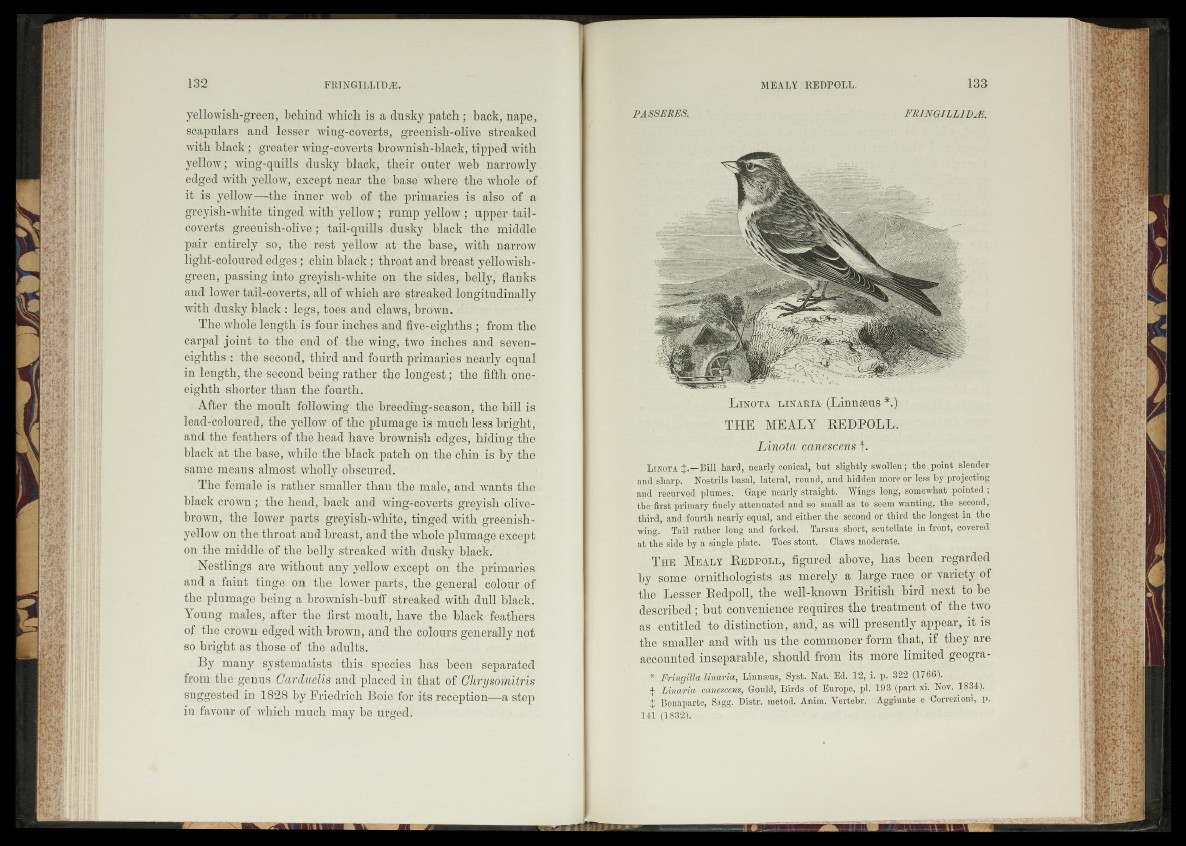
yellowish-green, behind which is a dusky patch; back, nape,
scapulars and lesser wing-coverts, greenish-olive streaked
with black; greater wing-coverts brownish-black, tipped with
yellow; wing-quills dusky black, their outer web narrowly
edged with yellow, except near the base where the whole of
it is yellow—the inner web of the primaries is also of a
greyish-white tinged with yellow ; rump yellow ; upper tail-
coverts greeuish-olive; tail-quills dusky black the middle
pair entirely so, the rest yellow at the base, with narrow
light-coloured edges ; chin black ; throat and breast yellowish-
green, passing into greyish-white on the sides, belly, flanks
and lower tail-coverts, all of which are streaked longitudinally
with dusky black : legs, toes and claws, brown.
The whole length is four inches and five-eighths ; from the
carpal joint to the end of the wing, two inches and seven-
eighths : the second, third and fourth primaries nearly equal
in length, the second being rather the longest; the fifth one-
eighth shorter than the fourth.
After the moult following the breeding-season, the bill is
lead-coloured, the yellow of the plumage is much less bright,
and the feathers of the head have brownish edges, hiding the
black at the base, while the black patch on the chin is by the
same means almost wholly obscured.
The female is rather smaller than the male, and wants the
black crown; the head, back and wung-coverts greyish olive-
brown, the lower parts greyish-white, tinged with greenish-
yellow on the throat and breast, and the whole plumage except
on the middle of the belly streaked with dusky black.
Nestlings are without any yellow except on the primaries
and a faint tinge on the lower parts, the general colour of
the plumage being a brownish-buff streaked with dull black.
Young males, after the first moult, have the black feathers
of the crown edged with brown, and the colours generally not
so bright as those of the adults.
By many systematists this species has been separated
from the genus Carduelis and placed in that of Ohrysomitris
suggested in 1828 by Friedrich Boie for its reception—a step
in favour of which much may be urged.
L in o ta l in a r ia (Linnaeus *.)
THE MEALY REDPOLL.
Linota canescens f.
Linota J .—Bill hard, nearly conical, hut slightly swollen; the point slender
and sharp. Nostrils basal, lateral, round, and hidden more or less by projecting
and recurved plumes. Gape nearly straight. Wings long, somewhat pointed;
the first primary finely attenuated and so small as to seem wanting, the second,
third, and fourth nearly equal, and either the second or third the longest in the
wing. Tail rather long and forked. Tarsus short, scutellate in front, covered
at the side by a single plate. Toes stout. Claws moderate.
T h e M ea ly R e d p o l l , figured above, has been regarded
by some ornithologists as merely a large race or variety of
the Lesser Redpoll, the well-known British bird next to be
described; but convenience requires the treatment of the two
as entitled to distinction, and, as will presently appear, it is
the smaller and with us the commoner form that, if they are
accounted inseparable, should from its more limited geogia-
* Fringilla linaria, Linnseus, Syst. Nat. Ed. 12, i. p. 322 (1766).
| Linaria canescens, Gould, Birds of Europe, pi. 193 (part xi. Nov. 1834).
+ Bonaparte, Sagg. Distr. metod. Anim. Vertebr. Aggiunte e Correzioni, p.
141 (1832).